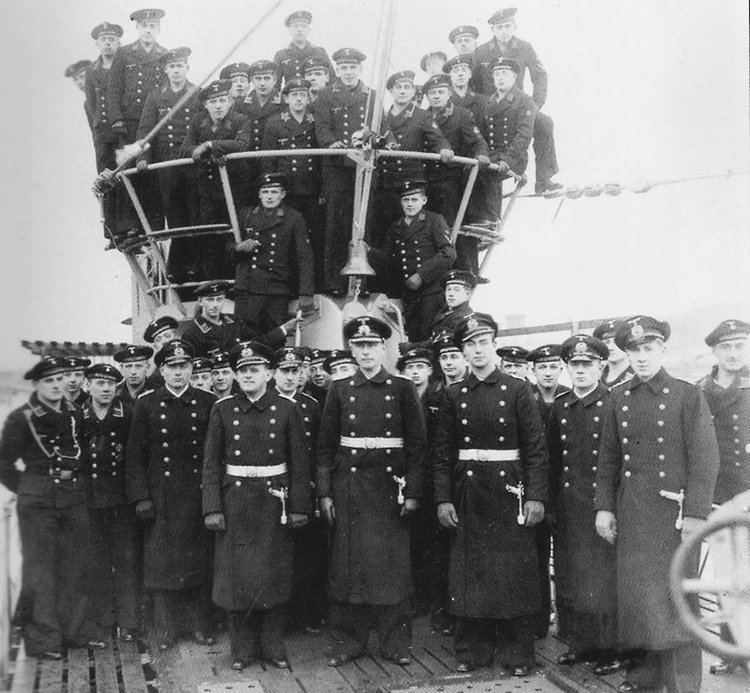Name U-173 Yard number 1013 Commissioned 15 November 1941 Construction started 21 December 1940 Length 77 m Beam 6.76 m | Ordered 23 December 1939 Laid down 21 December 1940 Fate Sunk, 16 November 1942 Launched 11 August 1941 Draft 4.7 m | |
 | ||
Part of 4th U-boat Flotilla, 2nd U-boat Flotilla | ||
German submarine U-173 was a Type IXC U-boat of Nazi Germany's Kriegsmarine during World War II.
Contents
She was laid down at the DeSchiMAG AG Weser yard in Bremen as yard number 1013, launched on 11 August 1941 and commissioned on 15 November with Fregattenkapitän Heinz-Ehler Beuke in command.
U-173 began her service career with training as part of the 4th U-boat Flotilla. She was reassigned to the 2nd flotilla for operations on 1 July 1942.
Design
German Type IXC submarines were slightly larger than the original Type IXBs. U-173 had a displacement of 1,120 tonnes (1,100 long tons) when at the surface and 1,232 tonnes (1,213 long tons) while submerged. The U-boat had a total length of 76.76 m (251 ft 10 in), a pressure hull length of 58.75 m (192 ft 9 in), a beam of 6.76 m (22 ft 2 in), a height of 9.60 m (31 ft 6 in), and a draught of 4.70 m (15 ft 5 in). The submarine was powered by two MAN M 9 V 40/46 supercharged four-stroke, nine-cylinder diesel engines producing a total of 4,400 metric horsepower (3,240 kW; 4,340 shp) for use while surfaced, two Siemens-Schuckert 2 GU 345/34 double-acting electric motors producing a total of 1,000 metric horsepower (740 kW; 990 shp) for use while submerged. She had two shafts and two 1.92 m (6 ft) propellers. The boat was capable of operating at depths of up to 230 metres (750 ft).
The submarine had a maximum surface speed of 18.3 knots (33.9 km/h; 21.1 mph) and a maximum submerged speed of 7.3 knots (13.5 km/h; 8.4 mph). When submerged, the boat could operate for 63 nautical miles (117 km; 72 mi) at 4 knots (7.4 km/h; 4.6 mph); when surfaced, she could travel 13,450 nautical miles (24,910 km; 15,480 mi) at 10 knots (19 km/h; 12 mph). U-173 was fitted with six 53.3 cm (21 in) torpedo tubes (four fitted at the bow and two at the stern), 22 torpedoes, one 10.5 cm (4.13 in) SK C/32 naval gun, 180 rounds, and a 3.7 cm (1.5 in) as well as a 2 cm (0.79 in) anti-aircraft gun. The boat had a complement of forty-eight.
1st patrol
The boat departed Kiel on 15 June 1942, moved through the North Sea and negotiated the gap between Iceland and the Faroe Islands. She crossed the Atlantic Ocean and entered the Caribbean Sea. She entered Lorient, on the French Atlantic coast, on 20 September.
2nd patrol
The submarine attempted the disruption of the Operation Torch landings (the invasion of North Africa) on 11 November 1942. She attacked convoy UGF-1 which was at anchor in Fedhala Roads. She hit three ships, sinking the USS Joseph Hewes and damaging two more. One of the damaged vessels, the destroyer USS Hambleton, was towed to nearby Casablanca where Seabees cut the ship in two, removed about forty feet of hull, then joined the two halves together again; she survived the war.
A few days later and further north, U-173 torpedoed but did not sink, the USS Electra, on 15 November. This vessel also survived the war, not being broken up until 1974.
Loss
The boat was sunk by depth charges from the American destroyers Woolsey, Swanson, and Quick in the Atlantic Ocean off Casablanca (33°40′N 7°35′W) on 16 November 1942.
